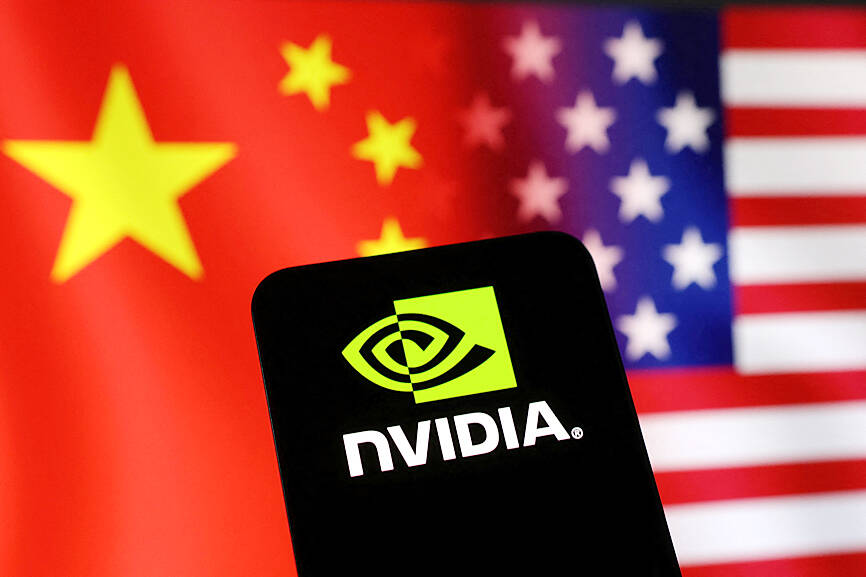Officials of US President Donald Trump’s administration are exploring additional curbs on the sale of Nvidia Corp chips to China, according to people familiar with the matter, who emphasized that conversations are in very early stages as the new team works through policy priorities.
Officials are focused on potentially expanding restrictions to cover Nvidia’s H20 chips, according to the people. That offering, which can be used to develop and run artificial intelligence (AI) software and services, is a scaled-down product designed to meet existing US curbs on shipments to China.
The people added that a decision on any restrictions is likely a long way off, given that the Trump administration is only beginning to staff up in relevant departments. US commerce secretary nominee Howard Lutnick, Trump’s pick to lead the agency that oversees chip trade curbs, said during a confirmation hearing on Wednesday that he would be “very strong” on semiconductor controls, without providing more specifics.

Photo: Reuters
Nvidia shares fell as much as 6.9 percent in New York on Wednesday, extending a rocky week for the chipmaker. An Nvidia spokesperson said in a statement that the company “is ready to work with the administration as it pursues its own approach to AI.”
A decision to tighten restrictions on Nvidia would be a further escalation of tensions between the world’s two largest economies. It comes as the US government and technology industry respond to evidence that China is further along in the AI race than anticipated.
For Nvidia, which has been under restrictions on what it can sell in China since 2022, an extension of the rules would further hurt its revenue in the largest market for semiconductors. The company has argued that restrictions reinforce Chinese determination to make itself independent of US technology and will weaken US companies — two things that run counter to the aims of the trade actions.
H20 is the result of previous rounds of restrictions that first required Nvidia to seek licenses for exports of its best AI chips. The company responded with downgraded variants — called H800 — that were not as powerful. Former US president Joe Biden’s administration then imposed tighter performance limits in 2023 that included that chip. Nvidia responded with the H20, a further scaled-down version.
The idea of tightening existing trade curbs to include H20 chips has been kicked around in Washington for some time. Staff in the Biden administration recommended such restrictions, but officials ultimately did not pursue the measures before leaving office, the people said.
Nvidia chips, already the most sought-after technology in the AI boom, are coming under even more intense scrutiny after Chinese start-up DeepSeek (深度求索) released a new AI model that it said rivals the performance of offerings from OpenAI, Alphabet Inc’s Google and Meta Platforms Inc. The Chinese company said its system was built at a fraction of the cost and used older Nvidia chips.

The US dollar was trading at NT$29.7 at 10am today on the Taipei Foreign Exchange, as the New Taiwan dollar gained NT$1.364 from the previous close last week. The NT dollar continued to rise today, after surging 3.07 percent on Friday. After opening at NT$30.91, the NT dollar gained more than NT$1 in just 15 minutes, briefly passing the NT$30 mark. Before the US Department of the Treasury's semi-annual currency report came out, expectations that the NT dollar would keep rising were already building. The NT dollar on Friday closed at NT$31.064, up by NT$0.953 — a 3.07 percent single-day gain. Today,

‘SHORT TERM’: The local currency would likely remain strong in the near term, driven by anticipated US trade pressure, capital inflows and expectations of a US Fed rate cut The US dollar is expected to fall below NT$30 in the near term, as traders anticipate increased pressure from Washington for Taiwan to allow the New Taiwan dollar to appreciate, Cathay United Bank (國泰世華銀行) chief economist Lin Chi-chao (林啟超) said. Following a sharp drop in the greenback against the NT dollar on Friday, Lin told the Central News Agency that the local currency is likely to remain strong in the short term, driven in part by market psychology surrounding anticipated US policy pressure. On Friday, the US dollar fell NT$0.953, or 3.07 percent, closing at NT$31.064 — its lowest level since Jan.

The New Taiwan dollar and Taiwanese stocks surged on signs that trade tensions between the world’s top two economies might start easing and as US tech earnings boosted the outlook of the nation’s semiconductor exports. The NT dollar strengthened as much as 3.8 percent versus the US dollar to 30.815, the biggest intraday gain since January 2011, closing at NT$31.064. The benchmark TAIEX jumped 2.73 percent to outperform the region’s equity gauges. Outlook for global trade improved after China said it is assessing possible trade talks with the US, providing a boost for the nation’s currency and shares. As the NT dollar

The Financial Supervisory Commission (FSC) yesterday met with some of the nation’s largest insurance companies as a skyrocketing New Taiwan dollar piles pressure on their hundreds of billions of dollars in US bond investments. The commission has asked some life insurance firms, among the biggest Asian holders of US debt, to discuss how the rapidly strengthening NT dollar has impacted their operations, people familiar with the matter said. The meeting took place as the NT dollar jumped as much as 5 percent yesterday, its biggest intraday gain in more than three decades. The local currency surged as exporters rushed to